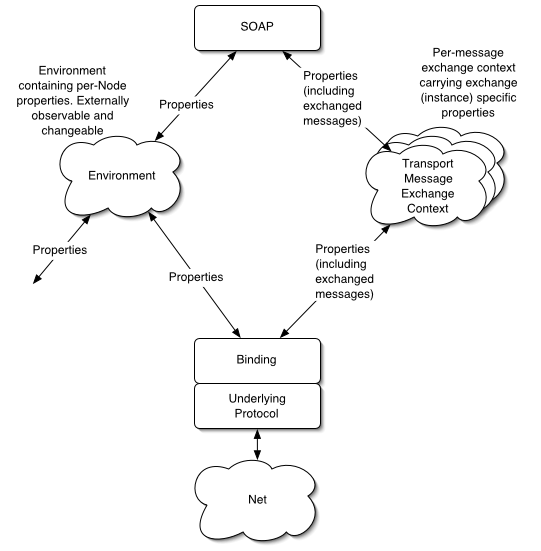C. Acknowledgements (Non-Normative)
This document is the work of the W3C XML Protocol Working Group.
Members of the Working Group are (at the time of writing, and by
alphabetical order): Yasser alSafadi (Philips Research),
Vidur Apparao (Netscape),
Camilo Arbelaez (WebMethods),
Mark Baker (Idokorro Mobile),
Carine Bournez (W3C),
Michael Champion (Software AG),
Paul Cotton (Microsoft Corporation),
Glen Daniels (Macromedia),
Paul Denning (Mitre),
Frank DeRose (Tibco),
Colleen Evans (Progress Software),
David Fallside (Chair, IBM),
Chris Ferris (Sun Microsystems),
Dietmar Gaertner (Software AG),
Marc Hadley (Sun Microsystems),
Gerd Hoelzing (SAP AG),
Oisin Hurley (IONA Technologies),
Yin-Leng Husband (Hewlett Packard),
John Ibbotson (IBM),
Ryuji Inoue (Matsushita Electric),
Kazunori Iwasa (Fujitsu Limited),
Murali Janakiraman (Rogue Wave),
Mario Jeckle (DaimlerChrysler Research & Technology),
Mark Jones (AT&T),
Anish Karmarkar (Oracle),
Jacek Kopecky (Systinet),
Yves Lafon (W3C),
Michah Lerner (AT&T),
Bob Lojek (Intalio),
Brad Lund (Intel),
Noah Mendelsohn (IBM),
Jeff Mischkinsky (Oracle),
Nilo Mitra (Ericsson),
Jean-Jacques Moreau (Canon),
Highland Mary Mountain (Intel),
Don Mullen (Tibco),
Masahiko Narita (Fujitsu Limited),
Eric Newcomer (IONA Technologies),
Henrik Frystyk Nielsen (Microsoft Corporation),
David Orchard (BEA Systems),
Andreas Riegg (DaimlerChrysler Research & Technology),
Herve Ruellan (Canon),
Marwan Sabbouh (Mitre),
Miroslav Simek (Systinet),
Simeon Simeonov (Macromedia),
Nick Smilonich (Unisys),
Lynne Thompson (Unisys),
Patrick Thompson (Rogue Wave),
Asir Vedamuthu (WebMethods),
Pete Wenzel (SeeBeyond),
Ray Whitmer (Netscape),
Volker Wiechers (SAP AG),
Stuart Williams (Hewlett Packard),
Amr Yassin (Philips Research),
Jin Yu (Martsoft)
Previous members were: Bill Anderson (Xerox),
Mark Baker (Sun Microsystems),
Philippe Bedu (Electricite de France),
Olivier Boudeville (Electricite de France),
Don Box (DevelopMentor),
Tom Breuel (Xerox),
Dick Brooks (Group 8760),
Winston Bumpus (Novell),
David Burdett (Commerce One),
Charles Campbell (Informix Software),
Alex Ceponkus (Bowstreet),
Miles Chaston (Epicentric),
David Clay (Oracle),
David Cleary (Progress Software),
Ugo Corda (Xerox),
Fransisco Cubera (IBM),
Ron Daniel (Interwoven),
Glen Daniels (Allaire),
Dug Davis (IBM),
Ray Denenberg (Library of Congress),
Mike Dierken (DataChannel),
Andrew Eisenberg (Progress Software),
Brian Eisenberg (DataChannel),
John Evdemon (XMLSolutions),
David Ezell (Hewlett Packard),
Eric Fedok (Active Data Exchange),
Daniela Florescu (Propel),
Dan Frantz (BEA Systems),
Michael Freeman (Engenia Software Corp),
Scott Golubock (Epicentric),
Rich Greenfield (Library of Congress),
Martin Gudgin (DevelopMentor),
Hugo Haas (W3C),
Mark Hale (Interwoven),
Randy Hall (Intel),
Bjoern Heckel (Epicentric),
Erin Hoffman (Tradia),
Steve Hole (MessagingDirect Ltd.),
Mary Holstege (Calico Commerce),
Jim Hughes (Fujitsu Software Corp),
Yin-Leng Husband (Compaq),
Scott Isaacson (Novell),
Eric Jenkins (Engenia Software),
Jay Kasi (Commerce One),
Jeffrey Kay (Engenia Software),
Richard Koo (Vitria Technology Inc.),
Alan Kropp (Epicentric),
Julian Kumar (Epicentric),
Peter Lecuyer (Progress Software),
Tony Lee (Vitria Technology Inc.),
Henry Lowe (OMG),
Matthew MacKenzie (XMLGlobal Technologies),
Murray Maloney (Commerce One),
Richard Martin (Active Data Exchange),
Noah Mendelsohn (Lotus Development),
Alex Milowski (Lexica),
Kevin Mitchell (XMLSolutions),
Ed Mooney (Sun Microsystems),
Dean Moses (Epicentric),
Rekha Nagarajan (Calico Commerce),
Raj Nair (Cisco),
Mark Needleman (Data Research Associates),
Art Nevarez (Novell),
Mark Nottingham (Akamai Technologies),
Conleth O'Connell (Vignette),
David Orchard (Jamcracker),
Kevin Perkins (Compaq),
Jags Ramnaryan (BEA Systems),
Vilhelm Rosenqvist (NCR),
Waqar Sadiq (Vitria Technology Inc.),
Rich Salz (Zolera)
Krishna Sankar (Cisco),
George Scott (Tradia),
Shane Sesta (Active Data Exchange),
Lew Shannon (NCR),
John-Paul Sicotte (MessagingDirect Ltd.),
Simeon Simeonov (Allaire),
Aaron Skonnard (Developmentor),
Soumitro Tagore (Informix Software),
James Tauber (Bowstreet),
Jim Trezzo (Oracle),
Randy Waldrop (WebMethods),
Fred Waskiewicz (OMG),
David Webber (XMLGlobal Technologies),
Yan Xu (DataChannel),
Susan Yee (Active Data Exchange).
The people who have contributed to discussions on
xml-dist-app@w3.org
are also gratefully acknowledged.

